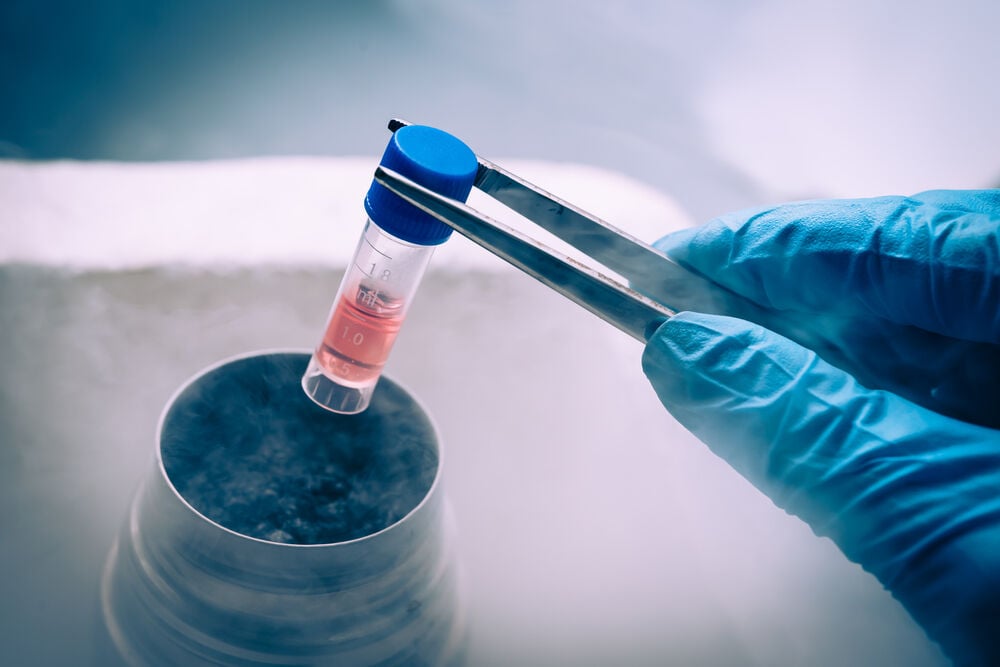Cryopreservation is a fertility-enhancing technique that addresses certain male and female reproductive issues. Below, Flo reviews the process of cryopreservation, its applications, and outcomes.
-
Tracking cycle
-
Getting pregnant
-
Pregnancy
-
Help Center
-
Flo for Partners
-
Anonymous Mode
-
Flo app reviews
-
Flo Premium New
-
Secret Chats New
-
Symptom Checker New
-
Your cycle
-
Health 360°
-
Getting pregnant
-
Pregnancy
-
Being a mom
-
LGBTQ+
-
Quizzes
-
Ovulation calculator
-
hCG calculator
-
Pregnancy test calculator
-
Menstrual cycle calculator
-
Period calculator
-
Implantation calculator
-
Pregnancy weeks to months calculator
-
Pregnancy due date calculator
-
IVF and FET due date calculator
-
Due date calculator by ultrasound
-
Medical Affairs
-
Science & Research
-
Pass It On Project New
-
Privacy Portal
-
Press Center
-
Flo Accuracy
-
Careers
-
Contact Us
Cryopreservation: How Life-Changing Sperm, Egg, or Embryo Freezing Prolongs Fertility


Every piece of content at Flo Health adheres to the highest editorial standards for language, style, and medical accuracy. To learn what we do to deliver the best health and lifestyle insights to you, check out our content review principles.
Cryopreservation definition
What is cryopreservation? It’s a method of preserving tissues, cells, organelles, or any other biological materials by drastically lowering the temperature of the samples.
The way living cells respond to the formation of ice is both a topic of practical relevance and theoretical interest. Researchers cannot store stem cells or other viable tissues (for general research and medical applications) for long periods of time. Ice crystals, membrane damage, and osmotic shock due to freezing and thawing kills these cells.
Fortunately, in recent years, efforts at cryopreservation with various cryoprotective agents (CPAs) and temperature-controlled equipment have proven increasingly successful. It’s critical to understand the chemical and physical reactions which occur during freezing and thawing to further the cryopreservation of cells.
Who needs cryopreservation?
One very significant application of the cryopreservation of cells is storing hematopoietic stem cells. They’re immature body cells which can develop into all kinds of blood cells and reside in the bloodstream and bone marrow. When a bone marrow rescue is performed with your own tissues, the surgeon collects hematopoietic stem cells prior to high-dose chemotherapy. Following treatment, they’ll thaw the cryopreserved cells and infuse them back into your body. Cryopreservation of cells shields them from the toxic effects of chemo, thereby improving outcomes for certain solid tumor cancers and lymphomas.
Leukemia patients, however, depend on donor stem cells or cryopreserved blood collected from newborn umbilical cords since their own blood cells are cancerous. Mesenchymal stem cells (derived from embryonic connective tissues) and hematopoietic stem cells can actually differentiate into bone, nerve, cardiac, or skeletal muscle tissues. They’re grown in tissue culture systems and utilized in therapies for heart and liver diseases, as well as muscle and nervous system disorders.
Profound hypothermia is a mild form of cryopreservation that has assisted with complex surgical heart procedures. Once a patient is put on a total cardiopulmonary bypass (with a heart-lung machine), their blood travels through a cooling chamber. Blood temperature drops to between 50 and 57 degrees Fahrenheit (10 and 14 degrees Celsius). The extremely low temperature ceases all brain activity and protects the vital organs.

For the moment, there is no blood circulation in the patient as the surgeon stops the heart-lung machine and corrects complex heart and blood vessel defects. After surgery is complete, the blood is gradually warmed up in the same chamber, and brain and organ function return to normal.
Note that cryopreservation may be used for storing veins, parathyroid glands, aortic tissue, and heart valves. When frozen properly, the process can extend cell and tissue life for more than ten years.
Not only is the cryopreservation of cells capable of saving lives, it’s also capable of creating it. Many couples have opted for the cryopreservation of embryos, eggs, or sperm. The first approach is especially valuable for saving extra embryos formed during in vitro fertilization (IVF). Couples may store them for future pregnancies or in the event that IVF isn’t successful with fresh embryos.
Take a quiz
Find out what you can do with our Health Assistant
Cryopreservation of eggs
The cryopreservation of eggs enhances a woman’s ability to conceive in the future. Unfertilized eggs are harvested from the ovaries, then frozen for later use. When needed, the frozen eggs are thawed and combined with sperm in a laboratory before being implanted in the womb during IVF.
Talk to your health care provider about how the cryopreservation of eggs works, potential risks, and whether it’s the right approach for prolonging your fertility.
Unlike embryo cryopreservation, which involves fertilized eggs, the cryopreservation of eggs does not require sperm. However, in both instances, fertility drugs must be taken to boost ovulation so there will be enough eggs to retrieve.
The cryopreservation of eggs is an ideal choice if you:
- Have sickle cell anemia, an autoimmune disease like lupus, or are dealing with gender-related changes that affect your ability to conceive
- Require treatment for malignancy such as chemotherapy or radiation which compromises future fertility
- Are currently undergoing IVF, or prefer the cryopreservation of eggs to embryo preservation for ethical or religious reasons
- Don’t feel ready to get pregnant now but want to preserve younger, healthier eggs to conceive with later in life
Cryopreservation of sperm
A reduction in germ cells (which create gametes or reproductive cells) sometimes occurs due to physical or chemical toxicity, genetic predisposition, or disease. Regardless of your current age, proper cryopreservation of sperm and semen could extend their viability almost indefinitely. In fact, clinical trials are being conducted on the cryopreservation of tissues from the testes but is still in its early stages.
Overall, sperm cryopreservation may be an appealing option for men having a vasectomy or undergoing surgery, radiotherapy, or chemotherapy.
Embryo cryopreservation
In 1972, two research groups reported the first successful embryo cryopreservation in a mouse. A year later, the first calf was born from a cryopreserved embryo. Eventually, the first human pregnancy was carried out in a similar process of embryo preservation. However, it was spontaneously aborted in the second trimester.
Since that time, the cryopreservation of sperm and embryos has routinely assisted with human reproduction. Embryo cryopreservation reduces the total quantity of fresh embryo removals/transfers and enhances the effectiveness of IVF.
Similarly, the cryopreservation of embryos plays a vital role when an embryo transfer is canceled due to circumstances that are beyond control. This includes potential ovarian hyperstimulation, endometrial bleeding, or high levels of serum progesterone on the triggering day.
On average, the likelihood of a cryopreserved embryo becoming a baby is about 4 percent. Furthermore, children created from frozen embryos represent only 8 to 10 percent of children resulting from all forms of assisted reproduction. Women who had both frozen and fresh embryo transfers were 8 percent more likely to have a live birth with a frozen embryo.
Despite the statistics, it’s still undeniable that the cryopreservation of embryos has significantly raised conception rates for couples doing IVF.
Does cryopreservation of cells really work?
The cryopreservation of cells relies on either vitrification or slow freezing, with the main differences lying in the cooling rate and the concentration of cryoprotective agents. With continuous advancements in freezing/thawing and osmotic conditions (of the solution surrounding a cell), the odds of success have greatly improved.
Higher functionality and survival rates among cell and tissue samples in cryopreservation translates to more clinical applications. Further research and testing of safe and effective cryopreservation methods could change the lives of millions of people all over the world.


Hey, I'm Anique
I started using Flo app to track my period and ovulation because we wanted to have a baby.


The Flo app helped me learn about my body and spot ovulation signs during our conception journey.


I vividly
remember the day
that we switched
Flo into
Pregnancy Mode — it was
such a special
moment.
Real stories, real results
Learn how the Flo app became an amazing cheerleader for us on our conception journey.




